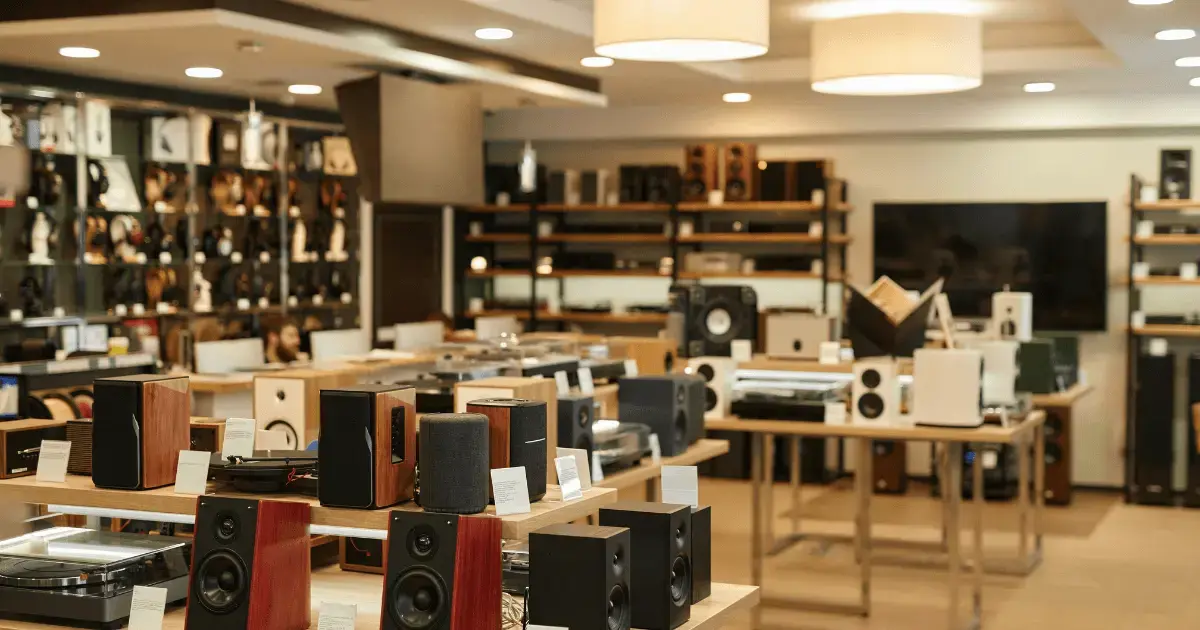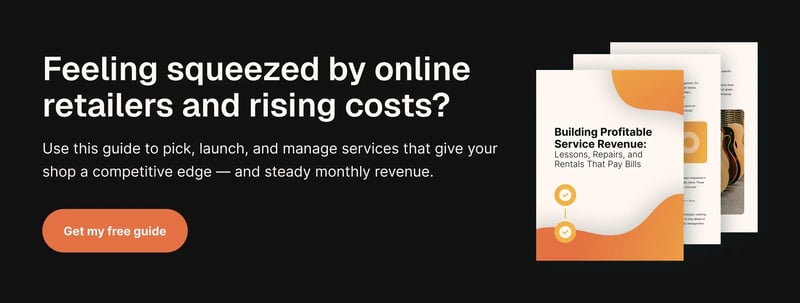
As a music store owner, you understand the importance of creating an inviting and engaging atmosphere. A thoughtfully designed space does more than just attract customers — it enhances their entire shopping experience. But before we explore specific design ideas, you need to know why visual merchandising matters.
To help you elevate your music shop’s appeal, we’ll share why visual merchandise displays matter, plus 11 fresh music store design ideas you can implement right away.
Why Store Displays Matter
Shopping is a multi-sensory journey that engages our senses in unique ways, with studies indicating that up to 83% of information is processed visually. This makes the aesthetics of your store important for capturing attention and encouraging purchases. Effective visual merchandising not only showcases your products, but tells a story about your brand, creating a memorable experience for customers.
Store displays play a significant role in this process, as their arrangement and presentation influence buying decisions and leave lasting impressions. With over 70% of shoppers planning to increase their in-store visits by the end of 2024, the desire to demo products — especially expensive items like musical instruments — remains a key motivator, making the "try before you buy" experience a must.
Here are some ways your displays make a difference:
1. Puts Your Best Impression Forward
Your music store's visual appeal plays a huge role in attracting customers. A well-organized and creatively designed display can make a memorable first impression and entice shoppers to enter and explore. Bright colors, engaging setups, and clear signage featuring musical terms and instruments all contribute to creating an inviting atmosphere that resonates with music lovers.
2. Encourages Exploration
Thoughtfully designed displays guide customers through your shop, encouraging them to explore different sections. By creating clear zones for guitars, drums, keyboards, and accessories, customers can easily navigate the space and discover products they might not have considered, increasing the likelihood of impulse purchases — like that vintage pedal or unique sheet music they didn’t plan on buying!
3. Enhances Customer Experience
An inviting display not only highlights your instruments — it enhances the overall shopping experience. Comfortable seating areas for jam sessions, interactive demo zones for trying out gear, and visually appealing arrangements can make customers feel at home, turning a simple shopping trip into an enjoyable outing filled with music and creativity.
4. Builds Brand Identity
Your displays reflect your store's brand and values. Unique and engaging setups can communicate your music shop's personality — whether it’s a cozy, family-friendly space with kid-sized instruments or an edgy, contemporary vibe showcasing the latest electric guitars. Consistent branding through your displays creates a stronger connection with your customers, so you can foster loyalty among musicians and music enthusiasts alike.
With these points in mind, let’s dive into 11 fresh music store design ideas to help you create a welcoming and engaging environment for your customers.
11 Unique Music Store Design Ideas
Here are some unique music store design ideas you can try to attract customers to your music shop. You can mix and match displays or try different setups at various times of the year. It may feel like trial and error, but remember that customers appreciate freshness, so experiment as much as you’d like.
1. Create Zones for Different Instruments
One of the most effective ways to organize your store is to create designated zones for different types of instruments. Consider setting up specific areas for guitars, drums, keyboards, and orchestral instruments.
This helps customers find what they're looking for quickly and allows you to tailor the ambiance for each section. A rock guitar zone could have edgy artwork, while a classical area might feature elegant displays and softer lighting.
Using a point of sale (POS) system can simplify this process. With advanced inventory management features, you can track which zones perform well and adjust your displays accordingly.
2. Set Up Seasonal Displays
Changing your displays with the seasons keeps your store feeling fresh and exciting. Think about showcasing holiday-themed items or back-to-school essentials in the late summer. Use colorful banners, props, and eye-catching signage to draw attention to your seasonal displays.
A solid POS system helps you track sales trends during different seasons, so you know which products to highlight. If an item is flying off the shelves, consider creating a seasonal display to capitalize on that momentum. For example, woodwind and brass instruments sell better during the back-to-school season, while expensive drum setups and electric guitars perform well during the holiday season.
3. Offer Interactive Demo Areas
Set up an interactive area where customers can try out instruments. Whether it’s a keyboard station, a drum set, or an area for guitars, giving customers the chance to play before they buy can significantly increase sales. Make the space comfortable, perhaps with seating nearby for friends or family to watch.
Your point of sale system facilitates this by allowing you to process sales from this area easily. Imagine a customer trying out a guitar and deciding to buy it on the spot — mobile POS setups make transactions seamless.
Related Read: Upselling and Cross-Selling: 8 Tips for Music Stores
4. Include a Kid-Friendly Instrument Section
A dedicated area for kids can attract families and encourage young musicians. Display colorful, easy-to-play instruments like ukuleles, xylophones, and small percussion instruments. This can spark interest in music among children and provide a fun shopping experience for parents.
Consider offering mini-lessons or demos specifically for kids. A POS system helps manage lesson sign-ups and track the popularity of different instruments among young shoppers.
5. Host In-Store Workshops
Hosting workshops can bring customers into your store and give them a reason to return. Consider offering basic classes on how to restring a guitar, tune a violin, or play simple songs. These hands-on experiences can foster a sense of community and make your store a go-to resource for musicians of all levels.
You can use your POS system to handle registrations and payments for these workshops. Plus, by tracking attendance, you can identify which topics resonate most with your customers.
6. Create a Cozy Atmosphere Beyond Instruments
Creating a cozy, inviting atmosphere is just as important as displaying your instruments. Use mannequins to showcase guitars or other instruments to give customers a sense of how they might look while playing.
You might also create a "Wall of Fame" where you showcase images of famous musicians you’ve worked with, as well as photos of regular customers and up-and-coming artists. Encourage them to write messages or leave their signatures, turning the space into a welcoming hangout rather than a sterile retail environment.
Remember: “Cozy” doesn’t mean worn or dated. Customers still prefer modern, clean design. If your musical instrument looks dated and neglected, it may give the impression that you aren’t up to date on the latest technology in music.
7. Showcase Local Musicians
Collaborating with local musicians can create a sense of community and bring foot traffic to your store. Set aside space for displays featuring local artists through framed photographs, signed instruments, or promotional materials. You might even host occasional live performances or open mic nights to attract more customers.
A POS system can help you track the sales of any merchandise related to these musicians. If a local artist’s album is selling well, you can feature it more prominently in your store.
8. Use Color Psychology
Colors have a significant impact on mood and behavior, so think carefully about your color scheme. Bright colors like red and yellow can energize and attract attention, making them great for promotional areas. Softer colors like blue or green can create a calming atmosphere, perfect for high-end instruments.
When redesigning your space, your POS system can assist in analyzing customer behavior. You might find that certain colors lead to more sales in specific areas, helping you refine your layout.
9. Incorporate Technology
Incorporating technology into your store can enhance the shopping experience. Think about using screens to display product videos, tutorials, or customer testimonials. We know that LED screens can be expensive, especially if you’re just starting out. In this case, consider using QR codes to provide customers with additional information about the instruments or accessories they’re interested in.
With a good POS system, you can easily manage the inventory for tech-related products, ensuring you always have the latest gear available.
10. Create a Cozy Lounge Area
Having a comfortable lounge area can encourage customers to spend more time in your store. Set up some comfy chairs or sofas where they can relax, play instruments, or even enjoy a cup of coffee. This can create a more inviting atmosphere and make your music store a community hub.
With your POS system, consider offering loyalty rewards for customers who hang out in your lounge and make purchases. This could encourage them to return, transforming casual visits into regular ones.
11. Update Your Website and Online Presence
Just like you refresh your in-store displays, make sure to update your website and any relevant online pages for your music store, too. What you do in-store can really resonate online, helping to create a cohesive theme across your marketing.
Online shoppers can get tired of seeing the same old guitars and gear, so keeping things fresh is important. With an integrated POS system that includes a website builder, updating your online store becomes simple — no need for an expensive coder. This way, your online presence can reflect the same excitement and energy you have in your music shop, so you can showcase your latest instruments and gear just as thoughtfully as you do in-store.
No matter how you choose to display your musical instruments, be sure to capitalize on wall space, keep everything clean and tidy, and consider the rule of symmetry in your displays. Customers often find symmetrical arrangements more visually appealing and less cluttered.
Related Read: How To Start an Online Music Instrument Store: 9 Simple Steps
Bring It All Together With Music Shop 360
Designing a music store is an ongoing adventure that blends creativity, strategy, and a solid understanding of what your customers want. By trying out these 11 music store design ideas, you can create a space that's inviting and keeps customers coming back for more.
If you’re looking to up your game, Music Shop 360 is here to help. This POS system is built specifically for music shop owners, making it easier to manage your displays. With features like label printer integration to keep everything organized, product-specific reminders to ensure your displays stay fresh, and a handy website builder to showcase your products online, you’ll be all set. Plus, order reminders and preorder options make sure your displays are always stocked with the latest and greatest.
So, if you're ready to elevate your store experience, schedule a free demo of Music Shop 360. Let’s see how this powerful tool can make your music store shine!




 by
by 



